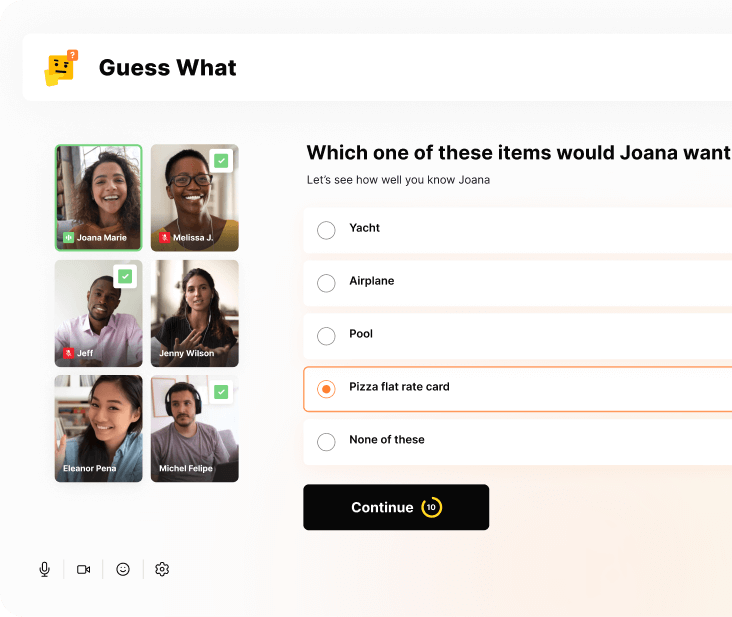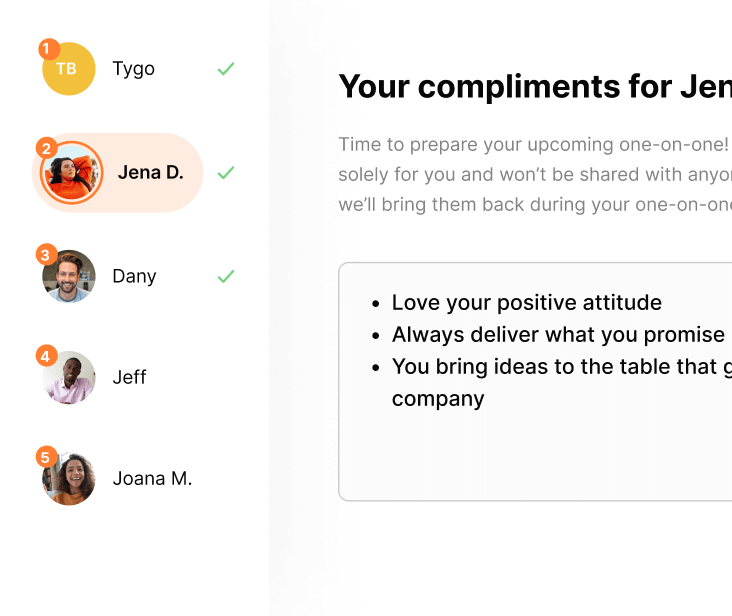Back to Blog
Employee engagement models: Which is best for your team?
Is your employee engagement program effective? Odds are, the answer is no.
90% of leaders understand the importance of employee engagement, but less than 50% have a plan to address it.
Unless your organization has a clear strategy for engaging employees, your managers' tactics are likely to disappoint. But where to start?
The best way to engage your employees and achieve proven results is by implementing an employee engagement model.
What is the theory of employee engagement?
Employee engagement theory is the idea that employers should actively engage their employees in the workplace. The theory suggests that when team members are engaged in the workplace, they are more likely to be productive and positively impact the company.
A variety of models have been developed to study why and how employees are engaged at work. These models offer an understanding of employee engagement and suggest strategies for developing it.
4 well-known employee engagement theories and models
There are many ways leaders can approach employee engagement in their organizations. Models of employee engagement can offer proven frameworks for success, making them a helpful tool alongside employee engagement solutions.
1. Kahn's theory of employee engagement
Psychologist William Kahn is considered the first academic to identify the concept of employee engagement. His research on personal engagement in the workplace culminated in his 1990 work, “Psychological Conditions of Personal Engagement and Disengagement”.
According to Kahn's model, there are three dimensions of employee engagement: physical, cognitive, and emotional. Levels of employee engagement can vary across these dimensions.
Kahn also identified three psychological conditions for employees to become engaged at work. These include finding their work meaningful, feeling safe, and being physically and emotionally available.
Learn more:
- Read Kahn's "Psychological Conditions of Personal Engagement and Disengagement at Work" online.
- Discover how an employee engagement platform can help improve your team's communication and sense of belonging.
2. Gallup's Employee Engagement Model and Q12 Survey
Using internationally-renowned research, workplace analytics group Gallup developed an employee engagement framework based on a hierarchy of employee needs. The following creates a pyramid, from bottom to top:
- Basic needs
- Individual contributions
- Teamwork
- Growth
Each level builds upon the previous one, creating a roadmap for managers to motivate and develop their team members.
The Gallup model is the basis for the well-known employee engagement survey, the Q12. This tool features 12 specific questions to measure engagement at each pyramid level.
Learn more:
- Check out the details of Gallup's Employee Engagement Survey.
- Here's the science behind Gallup's Q12 survey questions.
- What Gallup’s employee engagement survey tells us in 2022
Share fun facts and bond with a team quiz
Have your participants choose from a list of questions they’d like their coworkers to answer about them, before watching as they guess the right answer.
01. Yes
share-fun-facts-and-bond-with-a-team-quiz

Run a guided recognition activity
Have your participants choose from a list of questions they’d like their coworkers to answer about them, before watching as they guess the right answer.
01. Yes
run-a-guided-recognition-activity

Organize a virtual cooking class
Hire a professional chef to help your team cook a delicious lunch or dinner. May be difficult for co-workers with families. To find providers and get tips, read our blog about virtual cooking classes.
02. No
organize-a-virtual-cooking-class

Hire a stand-up comedian
Have your participants choose from a list of questions they’d like their coworkers to answer about them, before watching as they guess the right answer.
02. No
hire-a-stand-up-comedian

No items found
No items found
Table of contents
Is your employee engagement program effective? Odds are, the answer is no.
90% of leaders understand the importance of employee engagement, but less than 50% have a plan to address it.
Unless your organization has a clear strategy for engaging employees, your managers' tactics are likely to disappoint. But where to start?
The best way to engage your employees and achieve proven results is by implementing an employee engagement model.
What is the theory of employee engagement?
Employee engagement theory is the idea that employers should actively engage their employees in the workplace. The theory suggests that when team members are engaged in the workplace, they are more likely to be productive and positively impact the company.
A variety of models have been developed to study why and how employees are engaged at work. These models offer an understanding of employee engagement and suggest strategies for developing it.
4 well-known employee engagement theories and models
There are many ways leaders can approach employee engagement in their organizations. Models of employee engagement can offer proven frameworks for success, making them a helpful tool alongside employee engagement solutions.
1. Kahn's theory of employee engagement
Psychologist William Kahn is considered the first academic to identify the concept of employee engagement. His research on personal engagement in the workplace culminated in his 1990 work, “Psychological Conditions of Personal Engagement and Disengagement”.
According to Kahn's model, there are three dimensions of employee engagement: physical, cognitive, and emotional. Levels of employee engagement can vary across these dimensions.
Kahn also identified three psychological conditions for employees to become engaged at work. These include finding their work meaningful, feeling safe, and being physically and emotionally available.
Learn more:
- Read Kahn's "Psychological Conditions of Personal Engagement and Disengagement at Work" online.
- Discover how an employee engagement platform can help improve your team's communication and sense of belonging.
2. Gallup's Employee Engagement Model and Q12 Survey
Using internationally-renowned research, workplace analytics group Gallup developed an employee engagement framework based on a hierarchy of employee needs. The following creates a pyramid, from bottom to top:
- Basic needs
- Individual contributions
- Teamwork
- Growth
Each level builds upon the previous one, creating a roadmap for managers to motivate and develop their team members.
The Gallup model is the basis for the well-known employee engagement survey, the Q12. This tool features 12 specific questions to measure engagement at each pyramid level.
Learn more:
- Check out the details of Gallup's Employee Engagement Survey.
- Here's the science behind Gallup's Q12 survey questions.
- What Gallup’s employee engagement survey tells us in 2022
3. The Zinger model of employee engagement
The employee engagement model framework created by psychologist David Zinger also follows a pyramid structure. Also called the 10 building blocks of employee engagement, the Zinger model has four levels. From bottom to top, the core categories include:
- The necessities. Leverage strengths, make meaning, enhance wellbeing, and enliven energy
- Uniting the company. Build relationships, foster recognition, and master moments
- Boosting performance. Maximize performance and path progress
These layers form the foundation for the top block, the ultimate goal of achieving results.
The strength of this model lies in its simplicity, flexibility, and ability to see the big picture. It's easy for managers to digest and then take action on the employee engagement front.
Learn more:
- Read Zinger's "The Power of Employee Engagement" booklet.
- Get the building blocks to build your pyramid with these employee engagement apps, or start building your team right away.
4. The Aon Hewitt model of employee engagement
Aon Hewitt’s model of employee engagement combines rational thought with emotions, intentions, and behaviors to boost employee performance. As part of the model, employers can influence six employee engagement drivers:
- Quality of life
- Work
- Company practices
- People
- Opportunities
- Rewards
According to the Aon Hewitts model, engaged employees "Say, Stay, and Strive." They tell others positive things about the company, feel like they belong, desire to stay, and feel motivated to work hard to succeed.
Learn more:
- Take a look at the detailed Aon Hewitt model on page seven of this report.
- Explore how team building online can be a fun and effective way to say, stay, and strive.
A new model for employee engagement: Deloitte's 5 elements of irresistible organizations
Employee engagement statistics show that organizational power is shifting from employers to employees.
As Deloitte noted, companies need to change how they engage with their employees. Through extensive research and innovative ideas, Deloitte developed the Deloitte employee engagement model, a model that goes beyond simply engaging employees to create an organization that is irresistible.
For each of the five elements that make organizations "irresistible," Deloitte developed four strategies managers can use to encourage employee engagement.
1. Meaningful work
The right people need the right jobs, tools, and autonomy to succeed.
Strategies:
- Autonomy
- Small, empowered teams
- Time for slack
- Select to fit
2. Trust in leadership
Leadership is an essential element that can directly affect engagement.
Strategies:
- Transparency and honesty
- Mission and purpose
- Inspiration
- Continuous investment in people
3. Hands-on management
The management practices of middle managers significantly impact engagement and performance.
Strategies:
- Coaching
- Invest in developing management
- Clear, transparent goals
- Modern performance management
4. Positive work environment
Organizations today require flexible, humane, and inclusive work environments where employees feel connected to their teams.
Strategies:
- Flexible work environment
- Culture of Recognition
- Inclusive and diverse work environment
- Humanistic workplace
5. Growth opportunity
Employees want to feel supported and encouraged to develop and grow their skills.
Strategies:
- Facilitated talent mobility
- High-impact learning culture
- Self-directed, dynamic learning
- Training and support on the job
Ultimately, Deloitte says the key to an irresistible model is simplicity, emphasizing trust, autonomy, and cooperation.
Subscribe to get our latest updates
Subscribe to get our latest updates
.webp)





